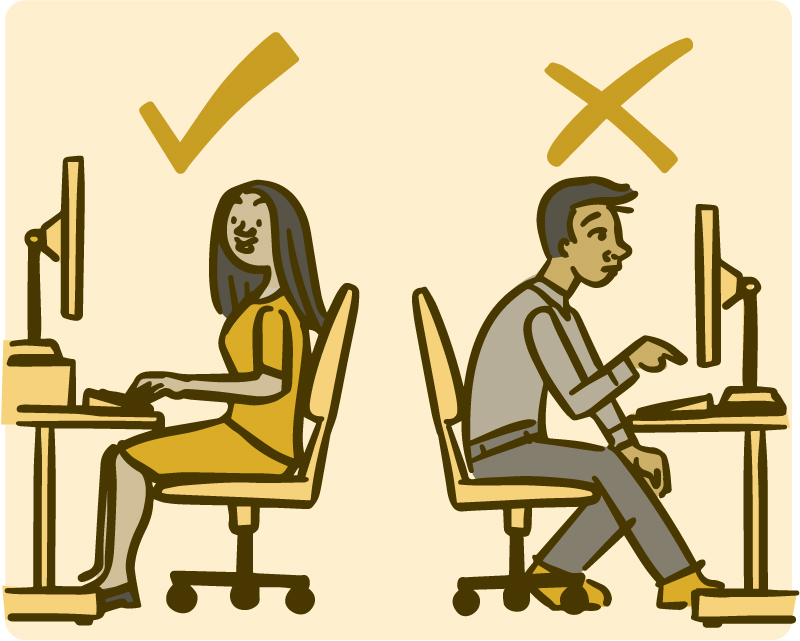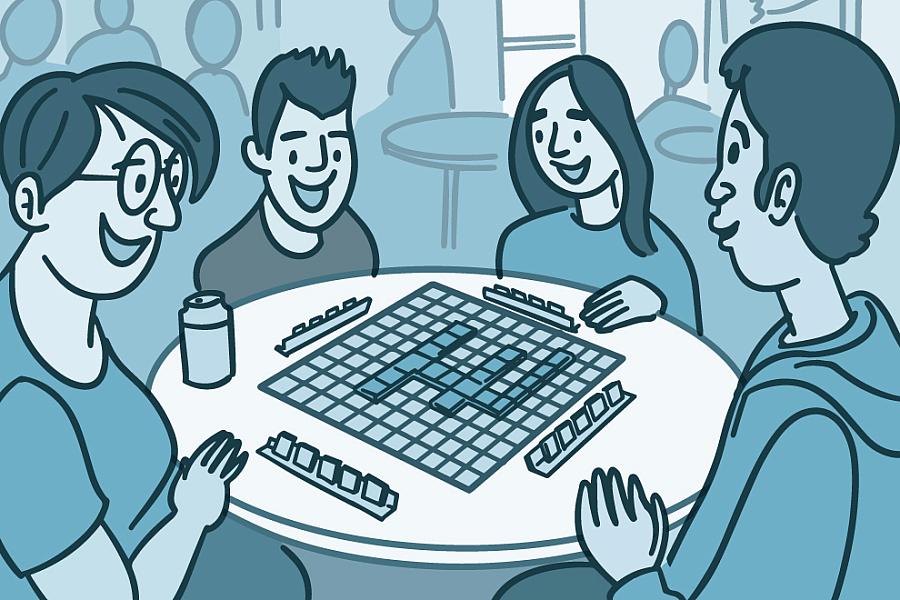Getting It Straight
Improve Your Posture for Better Health

Sit up straight! This common request may have been how you first heard about posture, the way you hold your body. Posture isn’t just about how you look. How you position yourself can help or hurt your health over your lifetime.
“Posture is not only about how well you sit, but how well you move and go about your daily life,” says Dr. George Salem, an NIH-funded researcher at the University of Southern California who studies how movement affects health and quality of life.
How you hold yourself when you’re not moving—such as when you’re sitting, standing, or sleeping—is called static posture. Dynamic posture is how you position your body while you’re moving, like walking or bending over to pick something up. “It’s important to consider both static and dynamic components of posture,” Salem says.
Posture can be affected by many things: your age, the situations you find yourself in, and your daily choices. For instance, children may have to adjust to carry heavy backpacks to school. Pregnant women move differently to accommodate growing babies.
Your posture involves your musculoskeletal system. This includes your bones, muscles, joints, and other tissues that connect the parts of your body together. It’s what provides form, support, stability, and movement to your body.
How you hold yourself can either align or misalign your musculoskeletal system. Throughout life, this system must adapt to the type of work you do, the hobbies you enjoy, how you use electronic devices, injuries, and even the kind of shoes you wear.
You may think that sitting with slumped shoulders or bending at your back instead of your knees sometimes won’t hurt you. But small changes in how you hold yourself and move can add up over a lifetime.
Years of slouching wears away at your spine to make it more fragile and prone to injury. Holding your body and moving in unhealthy ways often leads to neck, shoulder, and back pain. In any 3-month period, about 1 in 4 adults in the U.S. has at least 1 day of back pain.
Poor posture can also decrease your flexibility, how well your joints move, and your balance. It can impact your ability to do things for yourself and increase your risk for falls. Slumped posture can even make it more difficult to digest the food you eat and breathe comfortably.
Some research suggests a link between posture and mental health as well. “Someone with depression may appear more closed in, curved, and tend to look down,” says NIH physical therapist Dr. Cris Zampieri. “When people feel anxious, they may raise their shoulders.” Scientists are now explor-ing the connections between posture and how we think and process infor-mation in the brain.
Our bodies change as we age. These natural changes make it especially important for older adults to maintain good posture, strength, flexibility, and balance. “Older adults tend to adopt a progressively hunched posture,” says Salem. “When shoulders continue to round forward over time, it creates excessive loading on the shoulder joint. This can create injury and limit the independence of older adults.”
An extremely hunched posture, or hyperkyphosis, affects up to two-thirds of senior women and half of senior men. This posture has been associated with back pain, weakness, and trouble breathing. It can also limit everyday activities, like brushing your hair and dressing yourself.
Salem and other researchers have been studying the possible health benefits of yoga, particularly for older adults. Yoga is a mind and body practice that typically combines physical postures, breathing exercises, and meditation or relaxation. In one study, older adults with hyperkyphosis showed significant improvement and less rounded shoulders after a 6-month yoga program.
“More people are participating in yoga,” Salem says. “We’re using innovative tools—like motion analysis with high-speed cameras and platforms that measure force—to understand what yoga is actually doing and how it’s targeting the biological processes of our body.” Ultimately, Salem says these findings will help therapists and yoga instruct-ors design programs that are safe and effective for older adults. The team also plans to study other age groups and people with disabilities.
It’s never too early or late in life to work on improving your posture and how you move.
“One way to improve your posture is to be aware of it in the first place,” Zampieri says. “It’s important to take a look at your posture before it becomes a problem. Yoga, tai chi, and other types of classes that focus on body awareness and mindfulness can help you learn to feel what’s wrong in your own posture. They also help you connect your physical posture with your emotional state, offering benefits in both areas.”
Classes aren’t the only way to improve your posture. “Be mindful of your posture and how you’re moving,” Salem says. “Think about lifting your head, pulling your shoulders back, and tightening your abdominal muscles in everyday situations.” Be aware of repetitive postures, like regularly lifting heavy objects, and holding positions for a long time, like sitting at a computer all day at work.
“If you spend a lot of time in front of a computer, make sure you have a good setup,” says NIH physical therapist Dr. Jesse Matsubara. “It’s important that your workstation fits you the best it can. You should also switch sitting positions often, take brief walks around the office, and gently stretch your muscles every so often to help relieve muscle tension.”
The foundation of good posture is having a body that can support it. This means having strong abdominal and back muscles, flexibility, and a balanced body over your life. Another way to improve posture is to lose weight, especially around your gut. More than 2 out of 3 Americans are either overweight or obese. Extra weight weakens your abdominal muscles, causes problems for your pelvis and spine, and contributes to low back pain.
“It’s easy to develop suboptimal movement patterns after an injury or from years of pain,” Salem explains, “but people can learn to distribute their weight evenly and balance their bodies again.”
It’s important to work with a doctor to find the types of physical activity that can help you maintain your health and mobility. Talk to your health care providers if you feel pain, have an injury, or have had surgery. They can give you feedback on how you’re moving, help you avoid unhealthy movement patterns, and work with you to create a plan that’s best for you.
NIH Office of Communications and Public Liaison
Building 31, Room 5B52
Bethesda, MD 20892-2094
nihnewsinhealth@od.nih.gov
Tel: 301-451-8224
Editor:
Harrison Wein, Ph.D.
Managing Editor:
Tianna Hicklin, Ph.D.
Illustrator:
Alan Defibaugh
Attention Editors: Reprint our articles and illustrations in your own publication. Our material is not copyrighted. Please acknowledge NIH News in Health as the source and send us a copy.
For more consumer health news and information, visit health.nih.gov.
For wellness toolkits, visit www.nih.gov/wellnesstoolkits.




